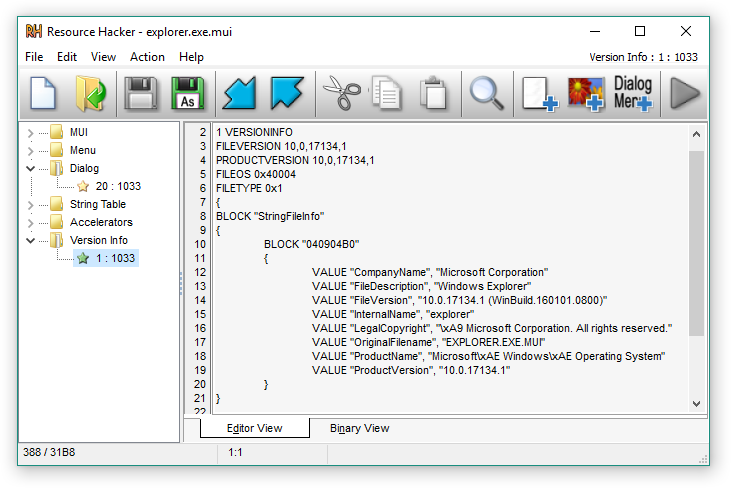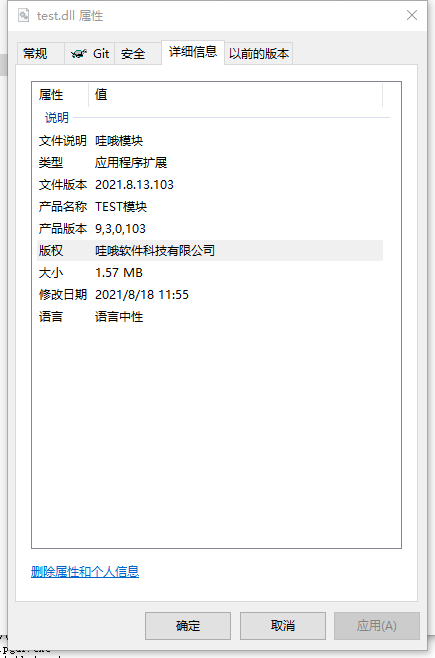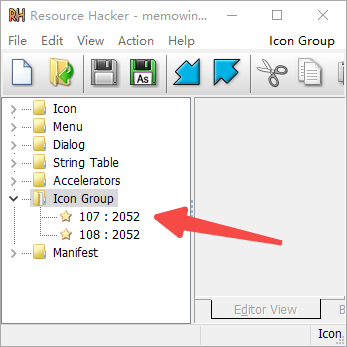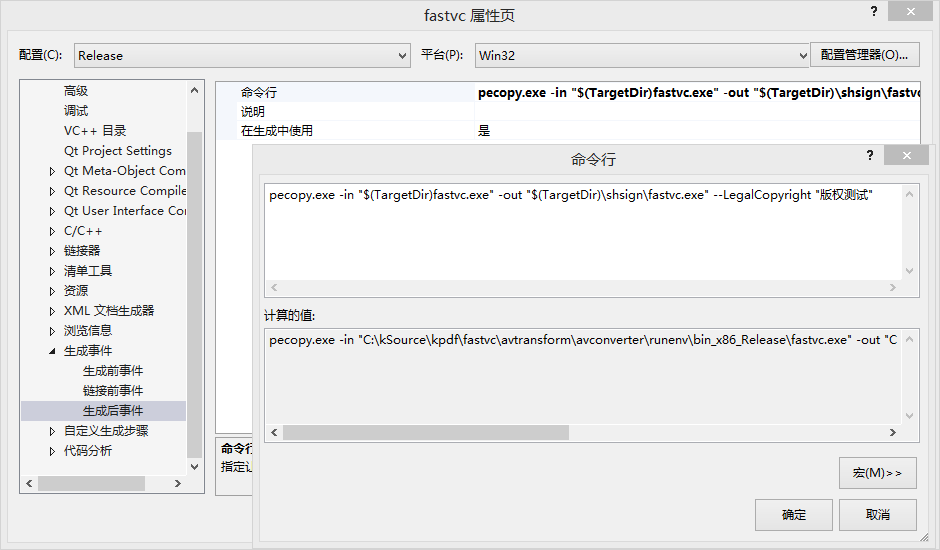编程与调试 -- Resource Hacker 修改 PE 描述信息
同样的代码发布三个版本,不同的描述信息,不同的签名,太麻烦!
- 构建一个,拷贝一下,然后手工改 PE 文件描述信息,手工打签名。麻烦!
- 构建两次,选择不同的构建配置。时间!时间!
pecopy.exe 解决你的烦恼!自动修改文件描述信息!下载地址:https://sunocean.life/tools/
https://sunocean.life/tools/pecopy.exe
Resource Hacker
图形界面版本。

pecopy.exe
pecopy.exe 解决你的烦恼, 通过配置构建生成后事件,同时完成拷贝和修改描述信息 ,最后签名。
- 一气呵成,不用介入。
- 避免构建多次,崩溃点都变了。
使用文档:
usage: "pecopy.exe" [-h] [-mcn COMPANYNAME] [-mfd FILEDESCRIPTION]
[-mvc FILEVERSION] [-min INTERNALNAME] [-mlc LEGALCOPYRIGHT]
[-mof ORIGINALFILENAME] [-mpn PRODUCTNAME]
[-mpv PRODUCTVERSION] [-icon ICONFILE] [-mask ICONMASK]
[-mcp CODEPAGE] -in INPUTFILE -out OUTPUTFILE [-debug DEBUG]
optional arguments:
-h, --help show this help message and exit
-mcn COMPANYNAME, --CompanyName COMPANYNAME
示例:酷哦软件科技有限公司
-mfd FILEDESCRIPTION, --FileDescription FILEDESCRIPTION
示例:酷哦工具箱好帮手
-mvc FILEVERSION, --FileVersion FILEVERSION
示例:2021,08,05,123
-min INTERNALNAME, --InternalName INTERNALNAME
示例:toolhelper
-mlc LEGALCOPYRIGHT, --LegalCopyright LEGALCOPYRIGHT
示例:酷哦软件科技有限公司
-mof ORIGINALFILENAME, --OriginalFilename ORIGINALFILENAME
示例:tool.exe
-mpn PRODUCTNAME, --ProductName PRODUCTNAME
示例:酷哦工具箱
-mpv PRODUCTVERSION, --ProductVersion PRODUCTVERSION
示例:1,0,0,123
-icon ICONFILE, --IconFile ICONFILE
示例:mainicon.ico
-mask ICONMASK, --IconMask ICONMASK
示例:ICONGROUP,107,2052(同时多个用半角分号隔开)
-mcp CODEPAGE, --CodePage CODEPAGE
示例:65001
-in INPUTFILE, --InputFile INPUTFILE
示例:tool.exe
-out OUTPUTFILE, --OutputFile OUTPUTFILE
示例:shsign\tool.exe
-debug DEBUG, --Debug DEBUG
示例 1 修改版权
C:\test>"pecopy.exe" -in "fastvc.exe" \
-out "shsign\fastvc.exe" \
--LegalCopyright "版权测试"
构建机构建完成,直接上去拿改好并签好名的文件即可。
示例 2 修改描述信息
"pecopy.exe" -in "$(TargetDir)\test.dll" \
-out "$(TargetDir)\shsign\test.dll" \
-mpn "TEST 模块" \
-mcn "哇哦软件科技有限公司" \
-mfd "哇哦模块" \
-mlc "哇哦软件科技有限公司"

已知缺陷:语言都会变成中性。这个应该影响不大。 如果此方案有帮助到项目组,记得豹趣积分打到 quanhai 账上。^_^
示例 3 修改图标
先要用 resourcehacker 看好要替换图标的 mask 是多少,比如:ICONGROUP,107,2052 。

"pecopy.exe" -in "pecopy.exe" \
-out "..\..\dist\pecopy.exe" \
-icon "..\image\icon\iconall\shitou.ico" \
-mask ICONGROUP,107,2052
- 微软图标格式文档:Icons
- png2ico 代码工具:http://www.winterdrache.de/freeware/png2ico/
- 微软图标设计文档:Icons (Design basics)
- C++ 如何将 Icon 转成 Bitmap,保留 Alpha 通道。http://www.noobyard.com/article/p-odzsipgl-hw.html
- 默认图标貌似是:
ICONGROUP,MAINICON,0。
配置构建生成后任务
- 把 pecopy.exe 入库到工程合适目录(建议入到 git,这样本机和构建机可以同时完成 pecopy)。
- 把
tempdir添加到根.gitignore。 - 配置生成后事件(一般根据工程当前的工程目录然后找到 pecopy.exe 的相对路径):
"pecopy.exe" -in "$(TargetDir)fastvc.exe" \ -out "$(TargetDir)shsign\fastvc.exe" \ --LegalCopyright "版权测试"

下载地址:https://sunocean.life/tools/ https://sunocean.life/tools/pecopy.exe
其它
2022-04-25 制作新版本,生成的文件会自动移除签名。
如果存在签名,修改描述前,最后用 VS 自带工具 signtool.exe 移除签名先。
signtool.exe remove /s target.dll
PE 文件的校验和(CheckSum)
note  IMAGE_OPTIONAL_HEADER.CheckSum 为一个 DWORD(64 位下也是 DWORD)型的校验值,用于检查 PE 文件的完整性,在一些内核模式驱动及 DLL 中,该值必须是存在且正确的。
IMAGE_OPTIONAL_HEADER.CheckSum 为一个 DWORD(64 位下也是 DWORD)型的校验值,用于检查 PE 文件的完整性,在一些内核模式驱动及 DLL 中,该值必须是存在且正确的。
校验值的计算很简单:
- 将 IMAGE_OPTIONAL_HEADER.CheckSum 清 0(因为这部分在文件中也是有值的,计算时得去掉)
- 以 WORD 为单位对数据块进行累加,记住要用 adc 指令而不是 add。
- 将累加和加上文件的长度(还是用 adc)
将计算结果与 IMAGE_OPTIONAL_HEADER.CheckSum 进行比较,不相等则说明文件被修改过或不完整。
ImageHlp Image Modification Functions https://docs.microsoft.com/zh-cn/windows/win32/debug/imagehlp-functions?redirectedfrom=MSDN
#include <windows.h>
#include<ImageHlp.h>
#pragma comment(lib, "ImageHlp.lib")
void main()
{
DWORD HeaderCheckSum = 0; // PE 头里的校验值
DWORD CheckSum = 0; // 计算下来的校验值
MapFileAndCheckSum(L"C:\\Users\\q4692\\Desktop\\ObjectHook.sys", &HeaderCheckSum, &CheckSum);
if (CheckSum == HeaderCheckSum)
{
MessageBox(NULL, L"相等", NULL, 0);
}
}
uint32_t calc_checksum(uint32_t checksum, void *data, int length) {
if (length && data != nullptr) {
uint32_t sum = 0;
do {
sum = *(uint16_t *)data + checksum;
checksum = (uint16_t)sum + (sum >> 16);
data = (char *)data + 2;
} while (--length);
}
return checksum + (checksum >> 16);
}
uint32_t generate_pe_checksum(void *file_base, uint32_t file_size) {
uint32_t file_checksum = 0;
PIMAGE_NT_HEADERS nt_headers = ImageNtHeader(file_base);
if (nt_headers) {
uint32_t header_size = (uintptr_t)nt_headers - (uintptr_t)file_base +
((uintptr_t)&nt_headers->OptionalHeader.CheckSum -
(uintptr_t)nt_headers);
uint32_t remain_size = (file_size - header_size - 4) >> 1;
void *remain = &nt_headers->OptionalHeader.Subsystem;
uint32_t header_checksum = calc_checksum(0, file_base, header_size >> 1);
file_checksum = calc_checksum(header_checksum, remain, remain_size);
if (file_size & 1){
file_checksum += (uint16_t)*((char *)file_base + file_size - 1);
}
}
return (file_size + file_checksum);
}
def set_exe_checksum(exe_path):
"""Set executable's checksum in its metadata.
This optional checksum is supposed to protect the executable against
corruption but some anti-viral software have taken to flagging anything
without it set correctly as malware. See issue #5579.
"""
import pefile
pe = pefile.PE(exe_path)
pe.OPTIONAL_HEADER.CheckSum = pe.generate_checksum()
pe.close()
pe.write(exe_path)
# You can use pe.verify_checksum() to verify that it is correct
# https://github.com/pyinstaller/pyinstaller/blob/master/PyInstaller/utils/win32/winutils.py
# https://github.com/pyinstaller/pyinstaller/blob/master/tests/functional/test_basic.py
# https://github.com/pyinstaller/pyinstaller/blob/master/PyInstaller/building/api.py
# Step 3: post-processing
if is_win:
# Set checksum to appease antiviral software. Also set build timestamp to current time to increase entropy
# (but honor SOURCE_DATE_EPOCH environment variable for reproducible builds).
logger.info("Fixing EXE headers")
build_timestamp = int(os.environ.get('SOURCE_DATE_EPOCH', time.time()))
winutils.set_exe_build_timestamp(build_name, build_timestamp)
winutils.update_exe_pe_checksum(build_name)
def fixup_exe_headers(exe_path, timestamp=None):
"""
Set executable's checksum and build timestamp in its headers.
This optional checksum is supposed to protect the executable against corruption but some anti-viral software have
taken to flagging anything without it set correctly as malware. See issue #5579.
"""
import pefile
pe = pefile.PE(exe_path, fast_load=False) # full load because we need all headers
# Set build timestamp.
# See: https://0xc0decafe.com/malware-analyst-guide-to-pe-timestamps
if timestamp is not None:
timestamp = int(timestamp)
# Set timestamp field in FILE_HEADER
pe.FILE_HEADER.TimeDateStamp = timestamp
# MSVC-compiled executables contain (at least?) one DIRECTORY_ENTRY_DEBUG entry that also contains timestamp
# with same value as set in FILE_HEADER. So modify that as well, as long as it is set.
debug_entries = getattr(pe, 'DIRECTORY_ENTRY_DEBUG', [])
for debug_entry in debug_entries:
if debug_entry.struct.TimeDateStamp:
debug_entry.struct.TimeDateStamp = timestamp
# Set PE checksum
pe.OPTIONAL_HEADER.CheckSum = pe.generate_checksum()
pe.close()
pe.write(exe_path)
如何移除已经签章的驱动程式
https://steward-fu.github.io/website/driver/wdm/remove_sign.htm
#include <stdafx.h>
#include <windows.h>
#include <imagehlp.h>
#pragma comment(lib, "Imagehlp.lib")
int main(int argc, char** argv)
{
HANDLE hFile;
hFile = CreateFile(argv[1], GENERIC_READ | GENERIC_WRITE, 0, NULL, OPEN_EXISTING, FILE_ATTRIBUTE_NORMAL, NULL);
ImageRemoveCertificate(hFile, 0);
CloseHandle(hFile);
return 0;
}
C/C++ 实现 PE 文件特征码识别 
#include <iostream>
#include <windows.h>
// 函数 MakeSureDirectoryPathExists() 所需头文件和 lib 库
#include <ImageHlp.h>
#pragma comment(lib, "imagehlp.lib")
int main()
{
// 在 C 盘创建名为“test”文件夹,并在 test 文件夹下再创建名为“1203”的文件夹。
int flag; // 保存返回值。如果目录存在,返回 TRUE;如果不存在但全部路径创建成功,返回 TRUE;如果不存在且创建失败,返回 FALSE。
flag = MakeSureDirectoryPathExists("E:\\test\\1203\\");
std::cout << "flag = " << flag << std::endl;
return 0;
}
多个 png 图片压缩成一个 ico
CMakeLists.txt
cmake_minimum_required(VERSION 3.10.2)
project(icopack)
add_executable(icopack icopack.cpp)
# cmake .. -G "Visual Studio 16 2019" -A Win32
icopack.cpp
编译好的,方便直接食用:icopack.zip (65K) 多张 png 图片压缩成一个 ico 文件,参考代码:
icopack out.ico favicon1.png favicon2.png favicon3.png
//
// icopack - pack multiple PNG images into an ICO file
//
// Copyright (c) 2021 Optidash GmbH
//
// Licensed under the GNU General Public License, Version 3 (the "License");
// you may not use this file except in compliance with the License.
//
// You may obtain a copy of the License at
// https://www.gnu.org/licenses/gpl-3.0.en.html
//
// Unless required by applicable law or agreed to in writing, software
// distributed under the License is distributed on an "AS IS" BASIS,
// WITHOUT WARRANTIES OR CONDITIONS OF ANY KIND, either express or implied.
// See the License for the specific language governing permissions and
// limitations under the License.
#include <stdint.h>
#include <string.h>
#include <stdio.h>
#include <stdlib.h>
int get_png_info(unsigned char *pIn, int iSize, int *width, int *height, int *bpp)
{
int w, h, i, j, bits=0;
if (pIn[0] != 0x89 || pIn[1] != 0x50 || pIn[2] != 0x4e || pIn[3] != 0x47) {
// PNG signature not present - not a PNG file
return 1;
}
// Parse enough of the PNG file to get to the image header (IHDR) to get
// the image size and bit depth
w = (pIn[16] << 24) | (pIn[17] << 16) | (pIn[18] << 8) | pIn[19];
h = (pIn[20] << 24) | (pIn[21] << 16) | (pIn[22] << 8) | pIn[23];
i = pIn[24]; // bits per pixel
j = pIn[25]; // pixel type
switch (j) {
case 0: // grayscale
case 3: // palette image
bits = i;
break;
case 2: // RGB triple
bits = i * 3;
break;
case 4: // grayscale + alpha channel
bits = i * 2;
break;
case 6: // RGB + alpha
bits = i * 4;
break;
}
*width = w; *height = h; *bpp = bits;
return 0;
} /* get_png_info() */
//
// Main program entry point
//
int main(int argc, char *argv[])
{
int i, j, iSize, iFileCount;
int width, height, bpp;
int iOffset;
FILE *ihandle, *ohandle;
unsigned char *pIn;
unsigned char ucTemp[512];
if (argc < 3 || argc > 16)
{
printf("icopack Copyright (c) 2021 Optidash GmbH\n");
printf("Combines multiple PNG images into a single ICO file\n");
printf("Source images must be <= 256 pixels in each dimension\n\n");
printf("Usage: icopack <outfile> <infile_1> <infile_2> <infile_N>\n");
printf("example:\n\n");
printf("icopack out.ico favicon1.png favicon2.png favicon3.png\n");
return 0; // no filenames passed
}
iFileCount = argc - 2;
ohandle = fopen(argv[1], "w+b");
if (ohandle == NULL) {
fprintf(stderr, "Unable to open output file: %s\n", argv[1]);
return -1; // bad filename passed
}
// write an empty header; we'll fill it in later
fwrite(ucTemp, 1, 6 + (iFileCount * 16), ohandle);
ucTemp[0] = 0; // ICONDIR structure starts with 0,0
ucTemp[1] = 0;
ucTemp[2] = 1; // ICON file (2 = cursor file)
ucTemp[3] = 0; // 2-byte int
ucTemp[4] = (unsigned char)iFileCount;
ucTemp[5] = 0; // 2-byte int
iOffset = 6 + (iFileCount * 16); // starting offset of first file data
for (i=2; i<argc; i++) { // collect all of the input files
ihandle = fopen(argv[i],"rb");
if (ihandle == NULL)
{
fprintf(stderr, "Unable to open input file: %s\n", argv[i]);
return -1; // bad filename passed
}
fseek(ihandle, 0L, SEEK_END); // get the file size
iSize = (int)ftell(ihandle);
fseek(ihandle, 0, SEEK_SET);
pIn = (unsigned char*)malloc(iSize);
if (pIn == NULL) {
fprintf(stderr, "Memory allocation error: size = %d\n", iSize);
return -1; // bad filename passed
}
fread(pIn, 1, iSize, ihandle);
if (get_png_info(pIn, iSize, &width, &height, &bpp)) {
fprintf(stderr, "Input files must be PNG; exiting...\n");
return -1; // bad filename passed
}
if (width > 256 || height > 256) {
fprintf(stderr, "image files cannot be larger than 256x256; exiting...\n");
return -1; // bad filename passed
}
// Fill in ICONDIRENTRY for this image
j = 6 + (i-2) * 16;
ucTemp[j] = (unsigned char)width;
ucTemp[j+1] = (unsigned char)height;
if (bpp < 8)
ucTemp[j+2] = (1 << bpp); // number of colors
else if (bpp == 8)
ucTemp[j+2] = 255;
else
ucTemp[j+2] = 0; // non-palette image
ucTemp[j+3] = 0; // reserved
ucTemp[j+4] = 1; // color planes
ucTemp[j+5] = 0; // 2-byte int
ucTemp[j+6] = bpp;
ucTemp[j+7] = 0; // 2-byte int
*(uint32_t *)&ucTemp[j+8] = iSize; // image file size
*(uint32_t *)&ucTemp[j+12] = iOffset; // offset to this image
iOffset += iSize;
// Write this image to the output file
fwrite(pIn, 1, iSize, ohandle);
free(pIn);
fclose(ihandle);
}
// Seek to the beginning and update the ICONDIR and ICONDIRENTRY structures
fseek(ohandle, 0, SEEK_SET);
fwrite(ucTemp, 1, 6 + (iFileCount * 16), ohandle);
fclose(ohandle);
return 0;
} /* main() */
icopack.py
单张图片自动生成 (16, 20, 24, 32, 40, 48, 64, 128, 256,) 各个级别的图片,然后压缩成一个 ico 文件。 如果图片不透明,顺便加一个圆角边框。参考代码:
#encoding=utf8
import re, os, sys
reldirx, _lidir = "", []
while not _lidir and len(reldirx) <= 100:
reldirx += "../"
checkfunc = lambda idir: os.path.exists(reldirx+idir+"/pythonx/funclib.py")
_lidir = [reldirx+idir for idir in os.listdir(reldirx) if checkfunc(idir)]
assert len(_lidir) in (0, 1), _lidir
if _lidir: reldirx = _lidir[0]
sys.path.append(reldirx)
from pythonx.funclib import *
from PIL import Image, ImageDraw
# https://stackoverflow.com/questions/11287402/how-to-round-corner-a-logo-without-white-backgroundtransparent-on-it-using-pi
def addCorners(im, rad):
rad = max(rad, 3) # 防御。
circle = Image.new('L', (rad * 2, rad * 2), 0)
draw = ImageDraw.Draw(circle)
draw.ellipse((0, 0, rad * 2, rad * 2), fill=255)
alpha = Image.new('L', im.size, 255)
w, h = im.size
alpha.paste(circle.crop((0, 0, rad, rad)), (0, 0))
alpha.paste(circle.crop((0, rad, rad, rad * 2)), (0, h - rad))
alpha.paste(circle.crop((rad, 0, rad * 2, rad)), (w - rad, 0))
alpha.paste(circle.crop((rad, rad, rad * 2, rad * 2)), (w - rad, h - rad))
im.putalpha(alpha)
return im
# https://docs.microsoft.com/en-us/windows/win32/uxguide/vis-icons
def mainfile(fpath, fname, ftype):
if not ftype in ("png", "jpg",):
return
if fpath.find("tempdir") != -1:
return
img = Image.open(fpath)
if img.mode == "RGB":
print("addCorners", fpath)
#img = img.convert('RGBA')
img = addCorners(img, int(img.size[0] / 8))
assert img.mode == "RGBA", img.mode
alpha = img.split()[-1]
total = 0
width, height = alpha.size
for x in range(width):
for y in range(height):
total += alpha.getpixel((x, y))
if total == width * height * 255:
print("addCorners", fpath)
img = img.convert('RGB')
img = addCorners(img, int(img.size[0] / 8))
imglist = []
for size in (16, 20, 24, 32, 40, 48, 64, 128, 256,):
newsize = (size, size)
# 用于表示改变图像过程用的差值方法。0:双线性差值。1:最近邻居法。2:双三次插值法。3:面积插值法。
#print(Image.BICUBIC) # 3
#print(Image.ANTIALIAS) # 1
temp = img.resize(newsize, resample=2)
local = os.path.join("tempdir", "icopack", fname, "%dx%d.png" % (size, size))
writefile(local, "")
osremove(local)
temp.save(local)
imglist.append(local)
target = fpath[:-4] + ".ico"
icodir = os.path.split(os.path.abspath(__file__))[0]
icopack = os.path.join(icodir, "icopack.exe")
cmdx = "\"{}\" ".format(icopack,) + target + " " + " ".join(imglist)
os.system(cmdx)
def main(rootdir):
print("rootdir", rootdir)
searchdir(rootdir, mainfile)
if __name__ == "__main__":
main(".")
main(os.path.split(os.path.abspath(__file__))[0])
看起来很优秀,没有试过的代码:
def bake_one_big_png_to_ico(sourcefile, targetfile, sizes=None):
"""Converts one big PNG into one ICO file.
args:
sourcefile (str): Pathname of a PNG file.
targetfile (str): Pathname of the resulting ICO file.
sizes (list of int): Requested sizes of the resulting
icon file, defaults to [16, 32, 48].
Use this function if you have one big, square PNG file
and don’t care about fine-tuning individual icon sizes.
Example::
sourcefile = "Path/to/high_resolution_logo_512x512.png"
targetfile = "Path/to/logo.ico"
sizes = [16, 24, 32, 48, 256]
bake_one_big_png_to_ico(sourcefile, targetfile, sizes)
"""
if sizes is None:
sizes = [16, 32, 48]
icon_sizes = [(x, x) for x in sizes]
Image.open(sourcefile).save(targetfile, icon_sizes=icon_sizes)
others
- pecopy.exe – PE 文件修改工具 。
- pesearch.exe – 二进制检索工具 ,输出报告。
- pereplace.exe – 二进制替换工具 。
- pecheck.exe – 二进制检查工具 ,进程退出码(-1),如果检查通过,进程退出码(0),方便集成到 vs 里面。
usage: pecheck.exe [-h] --jsonconfig JSONCONFIG --rootdir ROOTDIR pecheck.exe: error: the following arguments are required: --jsonconfig, --rootdir- 配置构建后事件:
..\..\bin\pecheck.exe --jsonconfig="..\..\config\pesearch.json" --rootdir="$(TargetPath)"
- 配置构建后事件:
参考资料快照
- http://www.rpi.net.au/~ajohnson/resourcehacker
- http://www.angusj.com/resourcehacker/
- https://docs.microsoft.com/en-us/previous-versions/ms997538%28v=msdn%2e10%29
- http://www.winterdrache.de/freeware/png2ico/
- https://docs.microsoft.com/en-us/windows/win32/uxguide/vis-icons
- http://www.noobyard.com/article/p-odzsipgl-hw.html
- https://blog.csdn.net/qq_39708161/article/details/79335914
- https://docs.microsoft.com/zh-cn/windows/win32/debug/imagehlp-functions?redirectedfrom=MSDN
- https://github.com/pyinstaller/pyinstaller/issues/5579
- https://github.com/pyinstaller/pyinstaller/blob/master/PyInstaller/utils/win32/winutils.py
- https://github.com/pyinstaller/pyinstaller/blob/master/tests/functional/test_basic.py
- https://github.com/pyinstaller/pyinstaller/blob/master/PyInstaller/building/api.py
- https://0xc0decafe.com/malware-analyst-guide-to-pe-timestamps
- https://steward-fu.github.io/website/driver/wdm/remove_sign.htm
- https://www.cnblogs.com/LyShark/p/13666403.html
- https://www.gnu.org/licenses/gpl-3.0.en.html
- https://stackoverflow.com/questions/11287402/how-to-round-corner-a-logo-without-white-backgroundtransparent-on-it-using-pi
 .
.